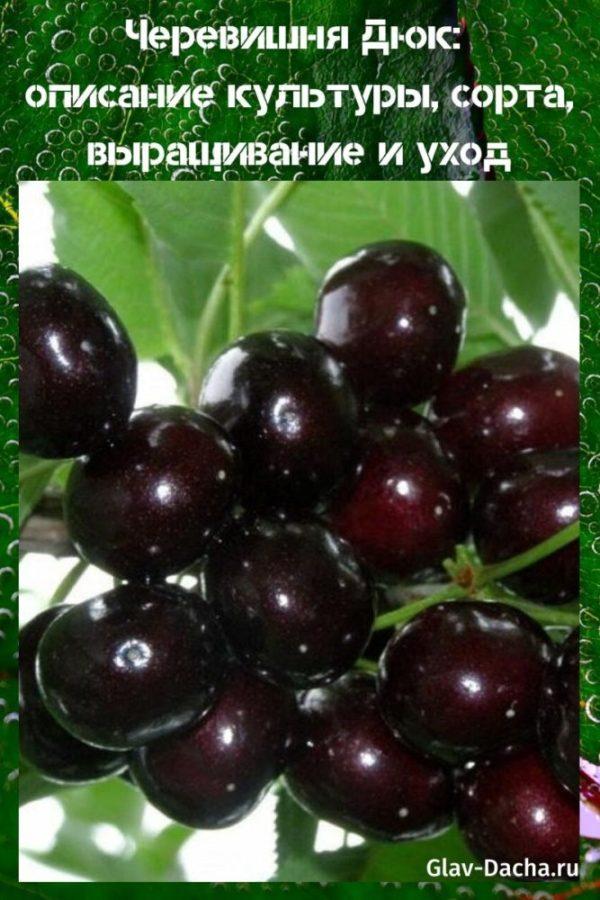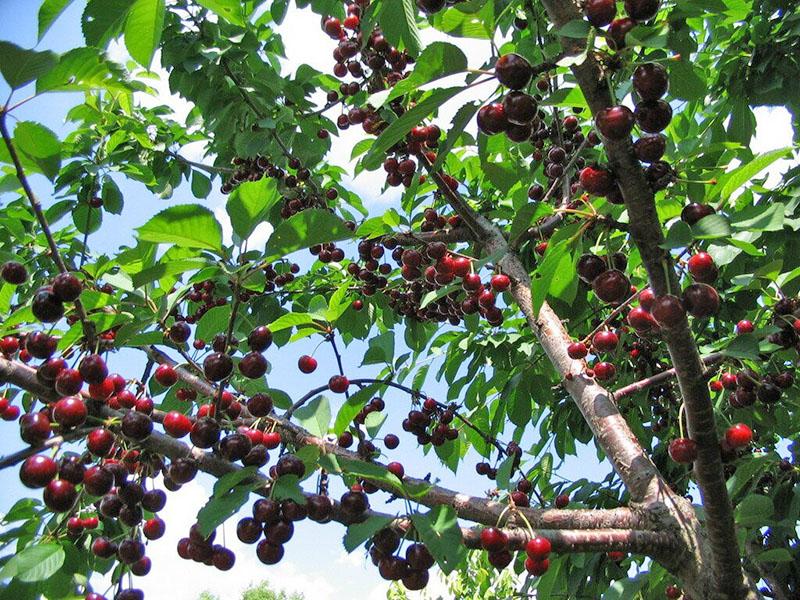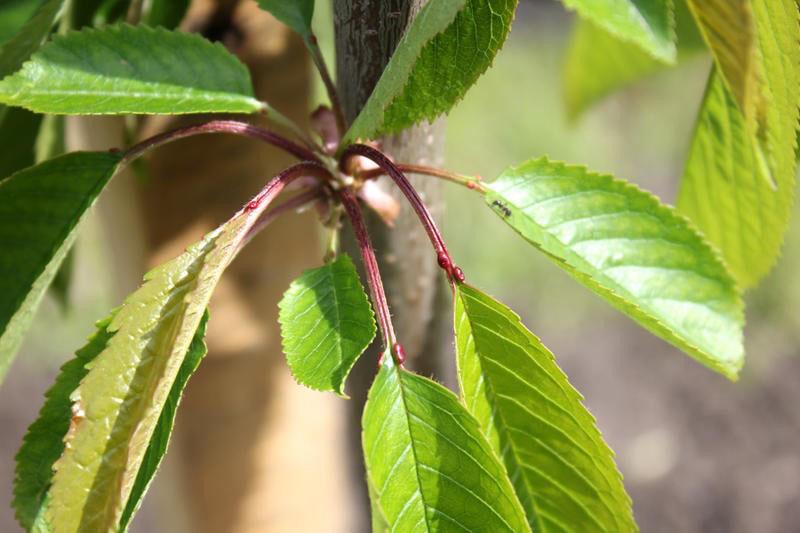Cherry Duke: description of the culture, varieties, cultivation and care
 The accidental reunion of two kindred "souls" led to the emergence of a unique culture in the 17th century. In foggy Albion, she was called the "Duke of May", and in Russia, it is just a sweet cherry Duke. Unlike its relatives, the plant miraculously tolerates cold winters and is resistant to fungal infections. The hybrid bears large, juicy fruits with cherry aroma, cherry pulp and unique sweetness. Let's take a closer look at the unique tree. We will learn how to grow it in a summer cottage. This will help to regularly collect bountiful harvests from a unique tree.
The accidental reunion of two kindred "souls" led to the emergence of a unique culture in the 17th century. In foggy Albion, she was called the "Duke of May", and in Russia, it is just a sweet cherry Duke. Unlike its relatives, the plant miraculously tolerates cold winters and is resistant to fungal infections. The hybrid bears large, juicy fruits with cherry aroma, cherry pulp and unique sweetness. Let's take a closer look at the unique tree. We will learn how to grow it in a summer cottage. This will help to regularly collect bountiful harvests from a unique tree.
Cherry Duke: external characteristic

 When spring comes, Cherry Duke first puts on a lush outfit of many leaves. They resemble cherries in shape, but the size is the same as those of cherries. The glossy surface is painted in a rich, bright green color. The plates are located on long petioles. The edges are pointed.
When spring comes, Cherry Duke first puts on a lush outfit of many leaves. They resemble cherries in shape, but the size is the same as those of cherries. The glossy surface is painted in a rich, bright green color. The plates are located on long petioles. The edges are pointed.
 Then, buds appear on the shoots of annual growth. In the south, they decorate the tree in April. In the middle latitudes - in early June. Pollinated specimens are converted to fruits.
Then, buds appear on the shoots of annual growth. In the south, they decorate the tree in April. In the middle latitudes - in early June. Pollinated specimens are converted to fruits.
The crop gives the first crop in the 3rd year after planting on the site.

Duke cherries differ in:
- dark red;
- dense juicy pulp;
- dessert sweetness;
- cherry aroma.
They ripen in the second decade of June. On average, one berry weighs about 10 g.
Bountiful harvests are harvested when the crop is 5 years old. One plant can produce about 15 kg of delicious fruits.
Advantages and disadvantages of a hybrid
 Each parenting culture has a number of positive aspects. Some of them were inherited by the new plant. Cherry Duke is resistant to infections that destroy the ovary and unripe fruit. For example, coccomycosis or moniliosis... She is not afraid of the cherry fly, which inhibits the development of young seedlings. The variety is resistant to cold winters. It successfully tolerates temperatures as low as 26 ° C. Not afraid of dry periods. Produces large fruits regularly.
Each parenting culture has a number of positive aspects. Some of them were inherited by the new plant. Cherry Duke is resistant to infections that destroy the ovary and unripe fruit. For example, coccomycosis or moniliosis... She is not afraid of the cherry fly, which inhibits the development of young seedlings. The variety is resistant to cold winters. It successfully tolerates temperatures as low as 26 ° C. Not afraid of dry periods. Produces large fruits regularly.
 Cherry Duke very quickly starts new branches, so it needs regular pruning. It is a self-fertile culture. Without additional pollinating trees, flowering buds will never be transformed into succulent fruits. In addition, the buds do not always tolerate spring frosts.
Cherry Duke very quickly starts new branches, so it needs regular pruning. It is a self-fertile culture. Without additional pollinating trees, flowering buds will never be transformed into succulent fruits. In addition, the buds do not always tolerate spring frosts.
Hybrid seedlings are very fragile, so they must be transported with extreme care.
Popular varieties
 The famous breeder I. Michurin in 1888 bred the first cherry variety Krasa Severa. It was distinguished by its special frost resistance. Every year it bore scarlet fruits with creamy yellow flesh. Over time, other varieties have appeared. Each variety differs in fruit size, ripening time and frost resistance. Let's get acquainted with the popular varieties of cherries for the Moscow region. Photos will help to represent their appearance.
The famous breeder I. Michurin in 1888 bred the first cherry variety Krasa Severa. It was distinguished by its special frost resistance. Every year it bore scarlet fruits with creamy yellow flesh. Over time, other varieties have appeared. Each variety differs in fruit size, ripening time and frost resistance. Let's get acquainted with the popular varieties of cherries for the Moscow region. Photos will help to represent their appearance.
Night
 The variety appeared by crossing cherries Valery Chkalov and cherries Nord Star.As a result, trees appeared on which large fruits appeared, weighing about 7 g. Inside there is a heart-shaped drupe. It is surrounded by juicy pulp with a dense texture. The glossy skin has a dark red tint. The berries are distinguished by a sweet and sour taste and a delicate cherry aroma. Full ripening occurs in mid-July. Fruiting begins 3 years after planting.
The variety appeared by crossing cherries Valery Chkalov and cherries Nord Star.As a result, trees appeared on which large fruits appeared, weighing about 7 g. Inside there is a heart-shaped drupe. It is surrounded by juicy pulp with a dense texture. The glossy skin has a dark red tint. The berries are distinguished by a sweet and sour taste and a delicate cherry aroma. Full ripening occurs in mid-July. Fruiting begins 3 years after planting.
Cherry Duke Nochka variety withstands winter frosts up to 30 ° C, so it is cultivated in regions with cool climates. A slightly acidic soil is suitable for cultivation. The plant loves sunny places where there are no drafts. For successful pollination, cherry varieties Molodezhny, Meteor, Nord Star and Tenderness cherries are planted nearby.
Pollinating trees should be located at a distance of 5 to 40 m.
Nurse
 Another name for the variety is Dessertnaya Sycheva. It was developed specifically for the northern regions of Russia. The tree has a round crown shape. The foliage looks more like cherry plates. Rounded berries form on bouquet shoots and weigh about 7-8 g. The surface of the skin is dark red. The pulp is very tender. Delivers a pleasant aroma. It has a sweet and sour taste.
Another name for the variety is Dessertnaya Sycheva. It was developed specifically for the northern regions of Russia. The tree has a round crown shape. The foliage looks more like cherry plates. Rounded berries form on bouquet shoots and weigh about 7-8 g. The surface of the skin is dark red. The pulp is very tender. Delivers a pleasant aroma. It has a sweet and sour taste.
 Cherry Nurse brings abundant harvests. In the northern regions, the fruits ripen at the end of July. They remain on the branches until the very end. Overripe berries have an amazing rich taste. Suitable for preparing compotes, marmalade and preserves. They do not lose their taste during transportation.
Cherry Nurse brings abundant harvests. In the northern regions, the fruits ripen at the end of July. They remain on the branches until the very end. Overripe berries have an amazing rich taste. Suitable for preparing compotes, marmalade and preserves. They do not lose their taste during transportation.
As you know, all cherries are self-fertile crops. Suitable pollinators for Duke Nurse are the following cherry varieties:
- Jealous;
- Lyubskaya;
- Bead.
Trees are planted in sunny, windless areas in spring or autumn. They are placed next to pollinators. Otherwise, the tree will not bear fruit.
High groundwater levels have a detrimental effect on hybrid development.
Spartan
 Medium-sized culture with a spreading crown. It is formed by vertically directed branches. All of them are abundantly covered with large oval-shaped foliage of dark green color. Spartan's height is up to 3.5 m. Rounded fruits are covered with shiny skin. The berries weigh about 8 g. They are colored crimson. The pulp is juicy and tender. About 15 kg of fruits are harvested from one tree.
Medium-sized culture with a spreading crown. It is formed by vertically directed branches. All of them are abundantly covered with large oval-shaped foliage of dark green color. Spartan's height is up to 3.5 m. Rounded fruits are covered with shiny skin. The berries weigh about 8 g. They are colored crimson. The pulp is juicy and tender. About 15 kg of fruits are harvested from one tree.
The famous variety Cherry Iput is used as pollinators, which miraculously endures cold winters. Spartan loves open sunny areas away from drafts. It develops successfully on sandy loam soil.
Rubinovka
 A low-growing hybrid of cherry and cherry grows up to a maximum of 2 m. Differs in abundant fruiting. Even in the absence of pollinating trees, it bears fruit. They ripen in the second decade of June. They have a pleasant sweet and sour taste. Cherry aroma exudes. Rubinovka develops wonderfully in the Moscow region, despite the harsh winters.
A low-growing hybrid of cherry and cherry grows up to a maximum of 2 m. Differs in abundant fruiting. Even in the absence of pollinating trees, it bears fruit. They ripen in the second decade of June. They have a pleasant sweet and sour taste. Cherry aroma exudes. Rubinovka develops wonderfully in the Moscow region, despite the harsh winters.
Hodos
 A distinctive feature of the variety is flattened berries. They are painted in dark cherry color. The large drupe easily detaches from the fetus. The pulp is elastic enough, so the fruits do not lose their presentation during transportation. Like all relatives of the variety, Duke Hodos prefers sunny and quiet areas. It successfully tolerates cold winters and dry summers.
A distinctive feature of the variety is flattened berries. They are painted in dark cherry color. The large drupe easily detaches from the fetus. The pulp is elastic enough, so the fruits do not lose their presentation during transportation. Like all relatives of the variety, Duke Hodos prefers sunny and quiet areas. It successfully tolerates cold winters and dry summers.
Secrets of growing a hybrid crop
 In order for the Duke cherry to appear on the summer cottage, first of all, you need to plant it correctly. There are several simple rules without which it is impossible to achieve success. Let's consider each of them in detail.
In order for the Duke cherry to appear on the summer cottage, first of all, you need to plant it correctly. There are several simple rules without which it is impossible to achieve success. Let's consider each of them in detail.
Purchase of a seedling

Quality trees are sold in specialized retail outlets. Important information is attached to the proposed copies:
- Duke's grade;
- ripening period;
- degree of frost resistance;
- the age of the seedling.
The most suitable are one- or two-year trees. They quickly take root in a new site. It is good if the root system consists of a strong central and several lateral roots.A seedling with mature wood with a uniform color without visible damage is suitable. Its height should be approximately 60 cm.
Duk cherries are planted in the spring in the northern regions, in the fall in the southern regions.
Choosing a comfortable site
 Hybrids prefer soil with neutral acidity. If necessary, liming the soil is carried out. Agronomists advise against planting cherries in valleys where water is stagnant. Otherwise, the tree will get sick and eventually die.
Hybrids prefer soil with neutral acidity. If necessary, liming the soil is carried out. Agronomists advise against planting cherries in valleys where water is stagnant. Otherwise, the tree will get sick and eventually die.
The most successful place for Duke is an open sunny area. However, there should be no drafts on it. The distance from neighboring crops is at least five meters. The plot begins to be prepared 15 days before planting the cherries. First, it is carefully dug up with a shovel. Then, they make a markup and dig a hole.
Funnel preparation
 If the hybrid is planned to be planted in the spring, a suitable hole is dug in the fall. Its width is about 60-70 cm, and its depth is 50-70 cm.
If the hybrid is planned to be planted in the spring, a suitable hole is dug in the fall. Its width is about 60-70 cm, and its depth is 50-70 cm.
Next, a nutrient substrate is prepared from the following components:
- humus (about 3 kg);
- wood ash (200 g);
- superphosphate (50 g);
- potassium sulfate (40 g);
- garden soil.
Fertilizers are thoroughly mixed with the ground. The resulting mixture is filled with about 75% of the total volume.
Planting cherry duke
 2-3 days before the start of the process, the root system of the seedling is dipped in a manganese solution to destroy pathogenic microbes and fungi. It is also kept in special growth stimulants. Most often they use "Kornevin" or "Zircon".
2-3 days before the start of the process, the root system of the seedling is dipped in a manganese solution to destroy pathogenic microbes and fungi. It is also kept in special growth stimulants. Most often they use "Kornevin" or "Zircon".
A stake is driven into the prepared funnel, which will be a reliable support for the seedling. Then the tree is placed in a hole. The roots are straightened, after which they are covered with soil. The root collar should protrude slightly above the ground. After planting, 2 buckets of warm water are poured onto the root area.
Watering rules
 Young seedlings are moistened every week to stimulate the successful development of the hybrid. Adult crops are watered less frequently. During dry periods, approximately 40 liters of water are used to irrigate crops. However, cherries do not like excessive moisture. It leads to decay of the root system, cracking of the upper cover of the trunk and branches.
Young seedlings are moistened every week to stimulate the successful development of the hybrid. Adult crops are watered less frequently. During dry periods, approximately 40 liters of water are used to irrigate crops. However, cherries do not like excessive moisture. It leads to decay of the root system, cracking of the upper cover of the trunk and branches.
Pruning
 The first time the procedure is carried out immediately after planting the culture. From the base to the top of the seedling should be no more than 60 cm. Therefore, the excess part of the branches is removed. The second pruning is done after 2 years. Lateral branches shorten 1/3 of the length. After wintering, the damaged elements are removed, thinned out and formed a crown. For mature trees that are over 5 years old, rejuvenating pruning is performed.
The first time the procedure is carried out immediately after planting the culture. From the base to the top of the seedling should be no more than 60 cm. Therefore, the excess part of the branches is removed. The second pruning is done after 2 years. Lateral branches shorten 1/3 of the length. After wintering, the damaged elements are removed, thinned out and formed a crown. For mature trees that are over 5 years old, rejuvenating pruning is performed.
We got acquainted with the external features of cherries, planting, care and pruning of culture. We looked at photos of popular species that are suitable for the Moscow region. We "tried" the taste of the sweet-sour berries of the hybrid. Now we can confidently start growing a unique variety in our summer cottage.